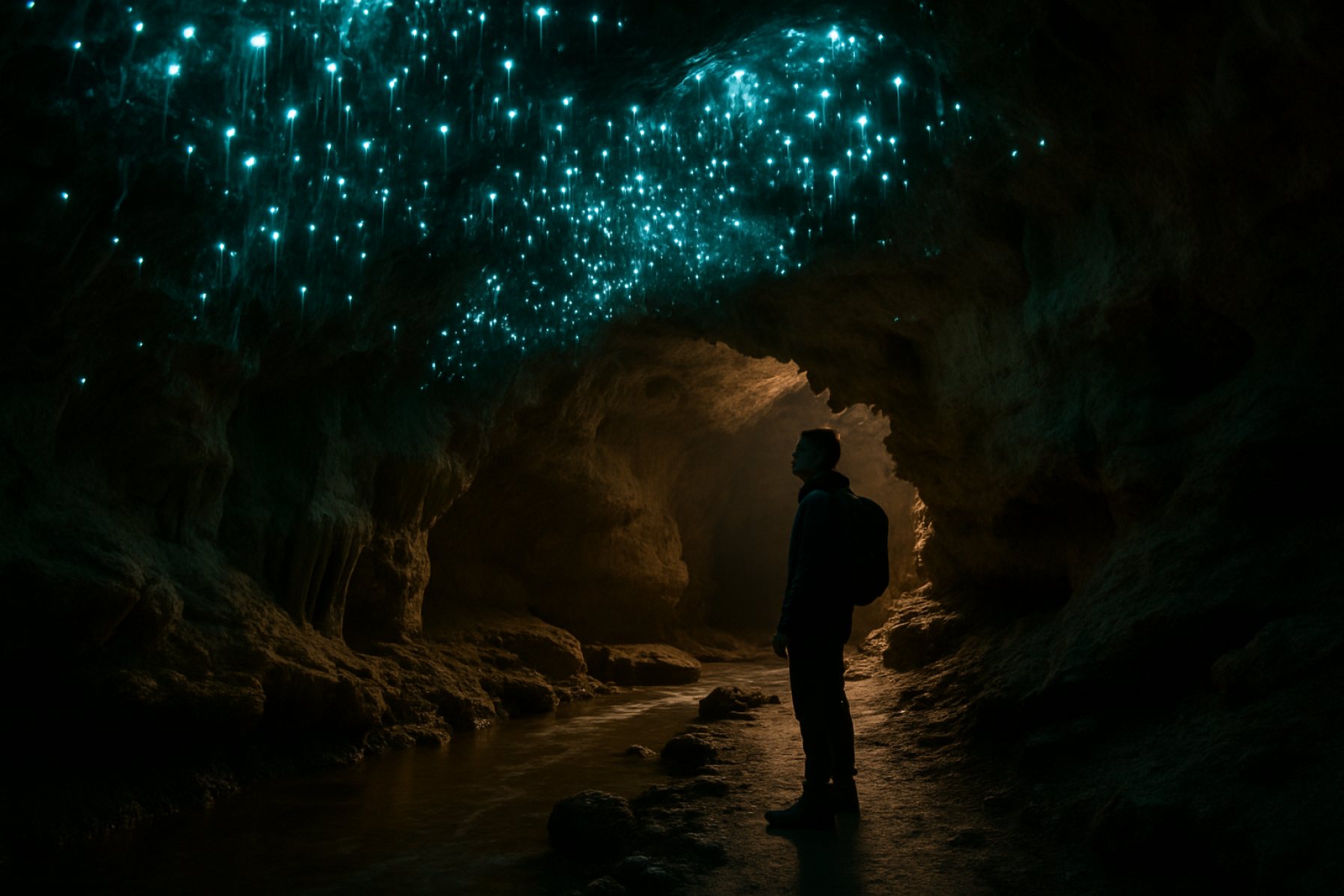Discover the Enchanting World of Glowworm Caves: Where Bioluminescent Wonders Illuminate Hidden Underground Realms. Explore the Science, Magic, and Mystique Behind These Natural Marvels.
- Introduction to Glowworm Caves
- The Science of Bioluminescence
- Famous Glowworm Cave Locations Around the World
- Unique Ecosystems and Cave Life
- Visitor Experiences and Guided Tours
- Conservation Efforts and Environmental Impact
- Tips for Planning Your Glowworm Cave Adventure
- Frequently Asked Questions About Glowworm Caves
- Sources & References
Introduction to Glowworm Caves
Glowworm caves are unique subterranean environments renowned for their bioluminescent inhabitants—glowworms, which are the larval stage of certain fungus gnat species. These caves, found primarily in New Zealand and Australia, offer a mesmerizing spectacle as thousands of glowworms emit a blue-green light, illuminating the cave ceilings and walls like a starry night sky. The most famous example is the Waitomo Glowworm Caves in New Zealand, which have attracted visitors for over a century due to their ethereal beauty and scientific significance (Waitomo Glowworm Caves).
The glowworms’ bioluminescence is a result of a chemical reaction involving luciferin, luciferase, oxygen, and adenosine triphosphate (ATP), which the larvae use to attract prey into their sticky silk threads. This adaptation is crucial for their survival in the nutrient-scarce cave environment. Glowworm caves are not only natural wonders but also important ecological sites, supporting unique microhabitats and delicate ecosystems. The caves’ stable temperature, high humidity, and darkness create ideal conditions for glowworm colonies to thrive.
Tourism in glowworm caves is carefully managed to preserve these fragile environments. Conservation efforts focus on minimizing human impact, maintaining cave humidity, and protecting the glowworm populations from external threats. As a result, glowworm caves serve as both a captivating natural attraction and a vital subject for scientific research into bioluminescence, cave ecology, and conservation practices (Department of Conservation New Zealand).
The Science of Bioluminescence
The enchanting glow that illuminates glowworm caves is the result of a natural phenomenon known as bioluminescence. In these unique environments, the primary light producers are the larvae of fungus gnats, most notably Arachnocampa luminosa in New Zealand. These larvae emit a blue-green light from specialized organs located in their tails. The light is produced through a chemical reaction involving the enzyme luciferase, the substrate luciferin, oxygen, and adenosine triphosphate (ATP). When these components interact, energy is released in the form of visible light, a process that is highly efficient and generates minimal heat.
Bioluminescence serves a crucial ecological function for glowworms. The emitted light attracts flying insects, which are then ensnared in the sticky silk threads suspended from the cave ceilings by the larvae. This adaptation is particularly effective in the dark, humid environments of caves, where other sources of light are absent. The intensity and duration of the glow can vary depending on factors such as the larva’s hunger level and environmental conditions, with hungrier larvae typically glowing more brightly to increase their chances of catching prey.
Scientific research into the biochemistry and ecological role of glowworm bioluminescence has provided insights into evolutionary adaptation and the potential applications of bioluminescent systems in biotechnology. For more detailed information on the science behind glowworm bioluminescence, visit the Department of Conservation and the Te Ara Encyclopedia of New Zealand.
Famous Glowworm Cave Locations Around the World
Glowworm caves are natural wonders found in select regions across the globe, where bioluminescent larvae illuminate subterranean passages with an ethereal blue-green glow. Among the most renowned is the Waitomo Glowworm Caves in New Zealand, home to the endemic species Arachnocampa luminosa. Visitors to Waitomo can experience boat rides beneath thousands of glowing larvae, creating a starry-sky effect on the cave ceilings. Another notable site in New Zealand is the Te Anau Glowworm Caves, located on the South Island, which offers guided tours through limestone passages and underground waterfalls illuminated by glowworms.
Australia also boasts several significant glowworm habitats. The Wollemi National Park in New South Wales features the Glow Worm Tunnel, a disused railway tunnel now inhabited by thousands of glowworms. In Queensland, the Cedar Creek Estate Glow Worm Cave on Tamborine Mountain offers a purpose-built environment for year-round viewing.
Beyond Australasia, glowworm caves are rare but can be found in limited locations. The Abingdon Lock in the United Kingdom is known for its population of the European glowworm, though these are typically found in outdoor environments rather than caves. The unique spectacle of glowworm caves remains a highlight for eco-tourists and nature enthusiasts, with conservation efforts ensuring these delicate ecosystems are preserved for future generations.
Unique Ecosystems and Cave Life
Glowworm caves are renowned for their unique subterranean ecosystems, which support a remarkable array of life forms adapted to perpetual darkness and high humidity. The most iconic inhabitants are the bioluminescent larvae of fungus gnats, commonly referred to as glowworms. These larvae emit a blue-green light to attract prey, creating the starry spectacle that draws visitors from around the world. The glowworms construct silk threads from the cave ceiling, which dangle and trap small insects lured by the light. This specialized predatory behavior is a striking example of adaptation to the cave environment, where food sources are scarce and competition is intense.
Beyond glowworms, these caves harbor a variety of other organisms, including cave-adapted insects, spiders, and fungi. Many of these species are endemic, having evolved in isolation over millennia. The constant temperature, high humidity, and absence of sunlight create a stable but challenging environment, fostering unique evolutionary pathways. Microbial communities thrive on the cave walls and in pools, playing a crucial role in nutrient cycling and supporting the broader cave ecosystem.
The delicate balance of these ecosystems makes them highly sensitive to external disturbances such as tourism, pollution, and climate change. Conservation efforts are essential to preserve both the glowworms and the intricate web of life that depends on the cave environment. Notable examples of protected glowworm cave ecosystems can be found in New Zealand’s Waitomo region, managed by the Waitomo Glowworm Caves, and in Australia’s Tamborine Mountain, overseen by the Tamborine Mountain Glow Worm Caves.
Visitor Experiences and Guided Tours
Visiting glowworm caves offers a unique and enchanting experience, drawing travelers from around the world to witness the bioluminescent displays created by thousands of glowworms illuminating the cave ceilings. Guided tours are the primary way to explore these delicate environments, ensuring both visitor safety and the preservation of the fragile ecosystems. Tours typically range from gentle boat rides along subterranean rivers to guided walks through limestone chambers, with knowledgeable guides providing insights into the biology of glowworms and the geological history of the caves.
In New Zealand, the Waitomo Glowworm Caves are among the most famous, offering a variety of tour options, including serene boat rides under a canopy of glowing larvae and adventure caving for the more intrepid. Australia’s Glow Worm Tunnel in New South Wales provides a self-guided experience, allowing visitors to walk through a historic railway tunnel now inhabited by glowworms. Most tours emphasize minimal disturbance to the glowworms, often requiring visitors to remain quiet, avoid flash photography, and refrain from touching cave surfaces.
The immersive atmosphere—marked by darkness, silence, and the ethereal blue-green glow—creates a sense of wonder and tranquility. Many visitors describe the experience as magical and otherworldly, making glowworm cave tours a highlight of eco-tourism in regions where these caves are found. Advance booking is recommended, especially during peak seasons, as group sizes are often limited to protect the cave environment and enhance the visitor experience.
Conservation Efforts and Environmental Impact
Glowworm caves, such as those found in New Zealand and Australia, are unique ecosystems that require careful conservation to maintain their delicate balance. The primary environmental impact on these caves stems from tourism, as thousands of visitors are drawn annually to witness the bioluminescent displays. Increased foot traffic, artificial lighting, and changes in humidity can disrupt the glowworms’ life cycles and reduce their populations. To mitigate these effects, strict conservation measures have been implemented in major sites like the Waitomo Glowworm Caves. These include limiting visitor numbers, constructing boardwalks to minimize habitat disturbance, and using low-impact lighting systems that do not interfere with the glowworms’ natural behavior (Waitomo Glowworm Caves).
Ongoing scientific monitoring is crucial for assessing the health of glowworm populations and their habitats. Researchers regularly track environmental parameters such as temperature, humidity, and carbon dioxide levels to ensure conditions remain optimal for the glowworms. Conservation programs also focus on public education, emphasizing the importance of preserving these fragile environments. Local communities and indigenous groups are often involved in stewardship, integrating traditional knowledge with modern conservation practices (Department of Conservation New Zealand).
Despite these efforts, climate change and land use changes outside the caves pose additional threats, potentially altering water flow and cave microclimates. Continued collaboration between scientists, local authorities, and tourism operators is essential to balance ecological preservation with sustainable visitor experiences, ensuring that glowworm caves remain a wonder for future generations.
Tips for Planning Your Glowworm Cave Adventure
Planning a visit to glowworm caves can be a magical experience, but a little preparation ensures you make the most of your adventure. First, research the best time to visit. Glowworms are most visible in complete darkness, so tours scheduled after sunset or in the evening offer the most spectacular displays. Some caves, like those managed by the Waitomo Glowworm Caves, offer both day and night tours, but evening tours are generally recommended for optimal viewing.
Booking in advance is highly advised, especially during peak tourist seasons, as popular sites can sell out quickly. Check the official websites for up-to-date information on tour availability, age restrictions, and accessibility. Many caves, such as those operated by New Zealand Department of Conservation, have specific guidelines to protect the delicate glowworm habitat, including restrictions on photography, noise, and touching cave surfaces.
Dress appropriately for the conditions—caves are often cool and damp, so wear warm layers and sturdy, non-slip footwear. Some tours provide waterproof jackets or boots, but it’s wise to check in advance. If you’re prone to claustrophobia, consider the size and duration of the tour, as some caves have narrow passages or require short boat rides.
Finally, respect the environment by following all instructions from guides and refraining from using flash photography, which can disturb the glowworms. By planning ahead and being mindful of conservation efforts, you’ll help preserve these unique ecosystems for future visitors while enjoying an unforgettable natural spectacle.
Frequently Asked Questions About Glowworm Caves
Glowworm caves are a source of fascination for travelers and scientists alike, prompting many common questions about their unique features and the bioluminescent creatures that inhabit them. Below are answers to some frequently asked questions about glowworm caves:
- Where are the most famous glowworm caves located? The most renowned glowworm caves are found in New Zealand, particularly the Waitomo Glowworm Caves, and in Australia, such as the Wollemi National Park.
- What species of glowworm is found in these caves? The primary species in New Zealand is Arachnocampa luminosa, while Australia is home to several species in the Arachnocampa genus. These insects are known for their bioluminescent larvae, which emit a blue-green light.
- How do glowworms produce light? Glowworms generate light through a chemical reaction called bioluminescence, which occurs in specialized organs. This light is used to attract prey and mates Department of Conservation (New Zealand).
- Are glowworm caves safe to visit? Yes, guided tours are generally safe and follow strict conservation guidelines to protect both visitors and the delicate cave ecosystems Waitomo Glowworm Caves FAQs.
- When is the best time to visit glowworm caves? Glowworms are visible year-round, but tours often recommend visiting after dusk for the most spectacular displays.
Sources & References
- Department of Conservation New Zealand
- Wollemi National Park
- Cedar Creek Estate Glow Worm Cave
- Abingdon Lock
- Tamborine Mountain Glow Worm Caves










